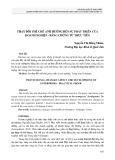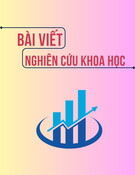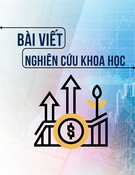
http://www.iaeme.com/IJM/index.asp 344 editor@iaeme.com
International Journal of Management (IJM)
Volume 7, Issue 7, November–December 2016, pp.344–351, Article ID: IJM_07_07_038
Available online at
http://www.iaeme.com/ijm/issues.asp?JType=IJM&VType=7&IType=7
Journal Impact Factor (2016): 8.1920 (Calculated by GISI) www.jifactor.com
ISSN Print: 0976-6502 and ISSN Online: 0976-6510
© IAEME Publication
THE HEART OF FINTECH REVOLUTION-BLOCK
CHAIN PERSPECTIVES AND IMPLICATIONS
Mansi Kapoor
Symbiosis Centre for Management Studies, Symbiosis International University (SIU)
Viman Nagar, Pune-14, Maharashtra, India
ABSTRACT
Fintech is an acronym which stands for the coming together of the world’s largest force
multipliers, finance and technology together to change the way people transact forever. It signifies
not only the coming together of these two behemoths but also coming of age of the fourth industrial
revolution, the term coined by Klaus Schwab, the founder and executive chairman of the World
Economic Forum. This revolution signifies the coming together of man and machine to co inhabit
planet earth and will cause a shift not only in how we know “homo economicus” but will redefine
the term humanity as well.
Cite this Article: Mansi Kapoor, The Heart of Fintech Revolution-Block Chain Perspectives and
Implications. International Journal of Management, 7(7), 2016, pp. 334–351.
http://www.iaeme.com/IJM/issues.asp?JType=IJM&VType=7&IType=7
Technical interventions in Finance – A Timeline
Finance is and will be the core of any economy and will set the trends in how people and businesses transact
with one another but so far, financial institutions and central banks have been driving the change but now,
technology has entered the space and has a greater role to play in not only how we transact but with what
and with who and how and consequently will alter lives in a very profound way.
The role of technology in finance began in the sixties with the invention of semiconductor
microprocessors which enabled data being captured and stored in a digital format. With mainframes in the
seventies, batch processing became possible. With terminals and personal computing in the eighties, we saw
the advent of automated banks and branches and also offline remote banking became a possibility. Also with
the proliferation of local networks, there was the intranet and corporate systems. The internet of the 1990s
of course made it possible to have global exchange of data and consequently the rise of the multinational
corporations.
Since 2015 however, technology is causing changes at an exponential rate. The technologies that been
driving not only banking and finance but also other sectors are cloud computing, cognitive computing,
machine learning or predictive analytics, quantum computing and robotics. These have been altering
business processes at lightening speeds. In short these technical interventions ensure that massive
quantum of data can be now not only processed but also analyzed in nano seconds. Analytics which was
a core human function can now be handled faster, with more precision by our machine counterparts.

The Heart of Fintech Revolution-Block Chain Perspectives and Implications
http://www.iaeme.com/IJM/index.asp 345 editor@iaeme.com
However, the technology that is firing the imagination of the finance and banking industry worldwide is
blockchain technology also called Distributed Ledger Technology or DLT .It is right now the heart of Fintech
and is all set to hit the pinnacle of the fourth industrial revolution.
Basics of Blockchain
• It was blockchain technology that was behind the invention of Bitcoins in the year 2008.
• The technology uses cryptography to create a shared ledger which is a digital ledger of transactions that
people in the network can see or access.
• This network is comprised of a chain of users in which all must approve an exchange before it can be verified
or recorded.
• For example if A wants to send money to B then in Blockchain technology :
• This transaction is represented online in a block.
• This block is broadcast to everyone in the network.
• Those in the network approve that the transaction is valid.
• Money is transferred from A to B
• The block is added to the chain.
• Each block provides an indelible and transparent record of transaction
• And so on, various blocks can keep getting added to the chain.
• To explain in a layman’s language, before the age of the internet, if we had to communicate with others we
would write a letter, put it in an envelope, buy a stamp and paste it on the corner, go to the nearby post box
and slide it in. Depending on the schedule of duty a person called the postman would make the rounds, could
be the same day or the next or a week later etc. The postman would put the letter in his leather satchel and
deposit it in the locality post office. The letter would then be sent to a central post office and after stamping
the date of the receipt, would again follow the same process in reverse. It would be handed over to the postman
of the area who would come and drop it to the person’s physical address. The whole process of sending and
receiving would take days, weeks or months depending on the geographical distance between the sender and
the receiver with off course the efficiency of the postal department playing a role as well. Step into the nineties,
with the internet, this process seems insane. We send an email which is received instantly by the person who
might be in any part of the world. Post Office ?? Postmen ??? Time ?????
The previous example referred to how the process of communication changed with the advent of internet
for data and information. Now imagine the future, but instead of moving data, we will be moving assets or
things we value. To take a simple example, suppose we want to transfer money to somebody. See what
happens now, we send a request (cheque, demand draft, online) to a bank in which we have an account. The
bank then transfers the money into the account of the person which might be with another bank. The process
called settlement takes hours, or days. (Though with SWIFT it’s faster)Again the process needs
intermediation and causes costs and delays. With blockchain technology what will essentially happen is this
exchange will happen instantly, just like an email. You send currency or money and it is received instantly
with just a ping.
The concept of money can now be extended to any asset which can be digitized, like shares, bonds, music
etc. In fact blockchain technology can even be used for elections and votes can be digitized.
• Blockchain Protocol is essentially based on the following core concepts :
• Chains hold blocks of information.
• Trusted Computing: These are technologies and proposals for enhancing computer security problems
through hardware and software interventions. This enhancement is a collaborative venture between a
group of vendors who call themselves Trusted Computed Group.

Mansi Kapoor
http://www.iaeme.com/IJM/index.asp 346 editor@iaeme.com
• Smart Contracts: These are contracts which have legal provisions embedded in the program so can be
executed automatically or in other words they self-execute. To take an example. We are now in a Shared
Economy of sorts. Suppose a person wishes to rent his/her car, like people rent out their apartments. The
person wishing to rent the car will forward a certain sum of money which will be sent first to pre agreed
smart contract algorithm ( Smart Contract) which would enable an authorization via the renters
smartphone , then this person would have access to the car . Within the contract would be build
mechanism for protection of the owner’s property which in this case is the car. The would be provisions
to monitor the drivers speed etc. . If the data captures over speeding or rash driving, a greater amount
would be deducted from the initial amount sent. Implying that third party interventions that are required
to ensure compliance of contracts will not be required.
• The distinguishable feature of DLT is that trust is embedded in the system, digital identity is created
and indelible traces of information is stored in blocks which can be accessed by the participants.
• Authorized participants can alter the ledger without awaiting approval from a central authority, often
resulting in faster and more secure transactions that can save institutions time and money.
Global Investments in Blockchain Technology
In August 2016, World Economic Forum released a report in association with Delloite titled “The future
of financial infrastructure- An ambitious look at how blockchain can reshape financial services. “The report
is based on twelve months of intense research involving experts from the entire spectrum of financial services
and beyond.
Five global workshops were held around the globe which bought together regulators, subject matter
experts, innovators and industry leaders. In 2015, the workshops were held in Singapore (October), New
York (November) followed by London (December) and in 2016 in Davos (January) and finally Sydney in
April.
According to this report
• Currently, more than 24 nations, 90 Central Banks and many corporates are working on this technology.
• More than 2500 patents have been filed worldwide.
• Over the last three years over 1.4 billion USD have already invested in blockchain.
• It is predicted that 80% of all banks will initiate blockchain projects by as early as 2017.
Many large central banks are funding startups which are working on blockchain applications.
R3, a blockchain startup founded in 2014 by a Wall Street professional David Rutter is a consortium
which consists of 30 large financial institutions that have agreed to develop and pilot blockchain
technologies. According to the R3 website, they describe themselves as “an alliance of the world’s largest
institutions, with a mission to realize the benefits of distributed ledger technology.” Its members include
Goldman Sachs, Morgan Stanley and Credit Suisse.
R3 is currently building “Corda” which is a distributed ledger designed to help member banks to use the
technology for interbank transactions and settlements.
It is reported that member banks have pledged 200 million dollars for development of blockchain
technology.
Some Key Blockchain Applications in Banking & Finance
A report released by Deloitte titled “Blockchain Applications in Banking,” specifically talks of two areas
where the technology will result in greater efficiency and huge cost savings. One is KYC and the other in
payment processing.

The Heart of Fintech Revolution-Block Chain Perspectives and Implications
http://www.iaeme.com/IJM/index.asp 347 editor@iaeme.com
According to the Deloitte report
• Efforts to check money laundering and financing of terror is currently extremely expensive and difficult.
• In 2014 , cost of compliance ,globally ,for banks was approximately 10 billion USD
• Apart from costs, the process causes delays which can range from 30 to 50 days.
• Due diligence also causes duplication of efforts amongst various agencies.
Currently, banks are fined rather heavily for failing to comply with KYC guidelines. Taking an example
from India, as recently as July 2016 RBI has imposed penalties to the tune of Rs. 27 Crores on 13 Banks for
Violating KYC and FEMA guidelines. Some of these penalties are as follows.
• Allahabad Bank – Rs. 2 Crores
• Syndicate Bank – Rs. 3 Crores
• Bank of Baroda – Rs. 5 Crores
• Canara Bank - Rs.2 Crores
• HDFC Bank – Rs.2 Crores
Internationally, according to a Thomson Reuters Survey, from the period 2004 to 2010 the monetary
penalties levied on banks are: HSBC (1.92 billion USD), Standard Chartered (327 million USD) and BNP
Paribas (8.9 billion USD). Also according to the report an average bank spends 40 million USD on KYC
Compliance.
According to the Delloite study referred to earlier
• Sharing of customer information is already taking place , eg SWIFT established KYC registry with 1125
sharing KYC information but so far this accounts for only 16% of the banks
• Use of DLT will automate processes and reduce chances of errors
• DLT will not only remove duplication of effort but the ledger will also enable encrypted updates to client
details to be distributed to all banks in near real time
• The ledger will also provide historical records of all documents shared and compliance activities taken for
each client.
Example
In Netherlands, Dutch banks are already partnering with INNOPAY which is a startup and has expertise in
Digital Identity and E-Business, to enroll a number of banks to use the distributed ledger amongst them.
Some of the key findings of the World Economic Forum report regarding blockchain
applications are as follows
• DLT has great potential to drive simplicity and efficiency through new processes.
• Operational Simplification: Reduces/eliminates manual efforts required to perform reconciliation and
in dispute resolution.
• Regulatory Efficiency Improvement: DLT will enable real time monitoring of activities.
• Counter Party Risk Reduction: Use of Smart Contracts and also because agreements will be codified
and executed in a shared immutable environment.
• Clearing and Settlement time reduction: There will be no need for third party that supports transaction
verification.
• Liquidity and Capital Improvement: Provide transparency into sourcing liquidity for assets.
• Fraud Minimization : Full transaction history will be recorded

Mansi Kapoor
http://www.iaeme.com/IJM/index.asp 348 editor@iaeme.com
• Applications of DLT will differ depending on the users, technology will be leveraged in different ways for
diverse benefits.
• Creation of Digital Identity is a key Enabler.
• Digital Fiat will amplify benefits.
• Impact of DLT will only be created when there is deep collaboration between innovators, regulators and
incumbents.
• DLT will redefine processes and challenge orthodoxies prevalent in the banking
International Trendsetters in DLT – A Case Study
Ripple – Enabling the Internet of Value
Founded in: 2015
CEO and Co-Founder: Chris Larsen
Profile: It is a venture backed start up with operations in San Francisco, New York. London, Luxembourg
and Sydney
Recent Funding: Has recently raised 55million dollars in venture capital. Key investors include Accenture,
Google Ventures and Standard Chartered.
Vision: “Ripple works with Banks to transform how they send money around the world- a necessary step to
compete in today’s global economy. Our Vision is to enable the internet of value so that the world can
move value the way it moves information today.”
Competitive Advantage: Their solutions lower the total cost of settlement by enabling banks to transact
directly, instantly and with certainty of settlement.
ACHIEVEMENTS AND INFLUENCE
• It is a member of the Federal Reserve’s Faster Payments Task Force Steering Committee
• It Co-Chairs the W3C’S Web Payments Working Group.
• As on September 15, 2016 their clients include Standard Chartered, National Australia Bank, Mizuho
Financial Group, Shanghai Huarui Bank
• Japanese Consortium of 15 Banks has also signed up.
• Ripple’s global network now includes 15 of the top 50 global banks, 10 banks in commercial deal phases, and
over 30 banks that have completed pilots.
CUSTOMER SPEAK
“With over $155 trillion of cross-border payments being made between businesses annually, it is crucial that
we continue to innovate to make international payments easier and faster not just for our clients but also for
the future of the payments industry. As a leading international bank committed to facilitating trade,
commerce and investments, this partnership will go a long way in progressing our digitization agenda to
develop innovative solutions for our clients.”
—Gautam Jain, Global Head, Digitization and Client Access, Transaction Banking, Standard
Chartered
Chain: Enabling a new medium for assets.
Founded in 2014
CEO- Adam Ludwin
Profile: Blockchain startup, headquartered in San Francisco






![Apple logo: Biểu tượng thương hiệu nổi tiếng, [Mô tả chi tiết/ Ý nghĩa/ Lịch sử (nếu có)]](https://cdn.tailieu.vn/images/document/thumbnail/2012/20121227/cuctim_1/135x160/9941356663005.jpg)


![Kinh nghiệm thử nghiệm nhanh laptop tại nơi mua [chuẩn nhất]](https://cdn.tailieu.vn/images/document/thumbnail/2012/20120919/bibocumi4/135x160/1244670_066.jpg)













![Bộ câu hỏi trắc nghiệm Đổi mới và sáng tạo [mới nhất]](https://cdn.tailieu.vn/images/document/thumbnail/2025/20251007/kimphuong1001/135x160/56111759828894.jpg)


